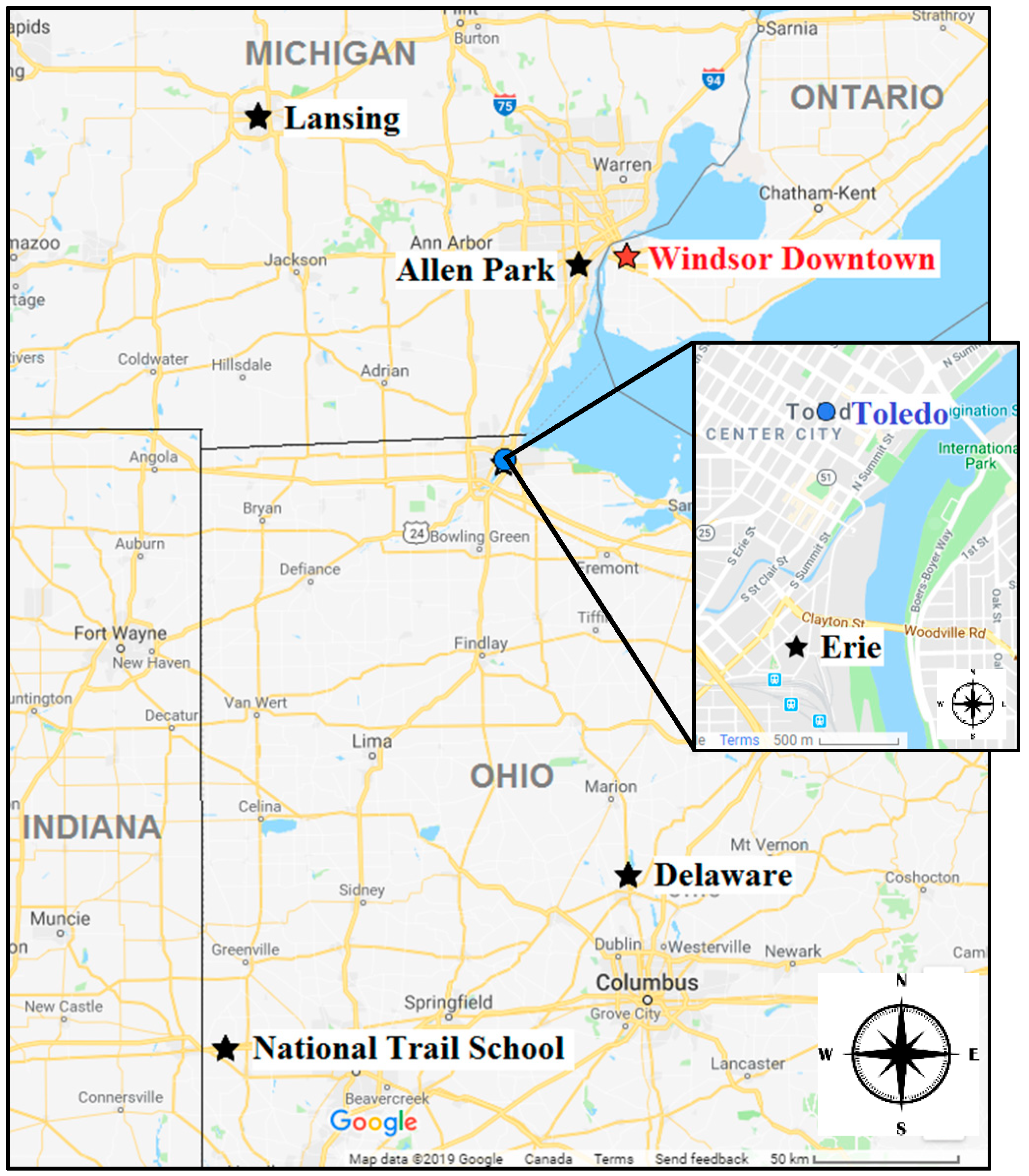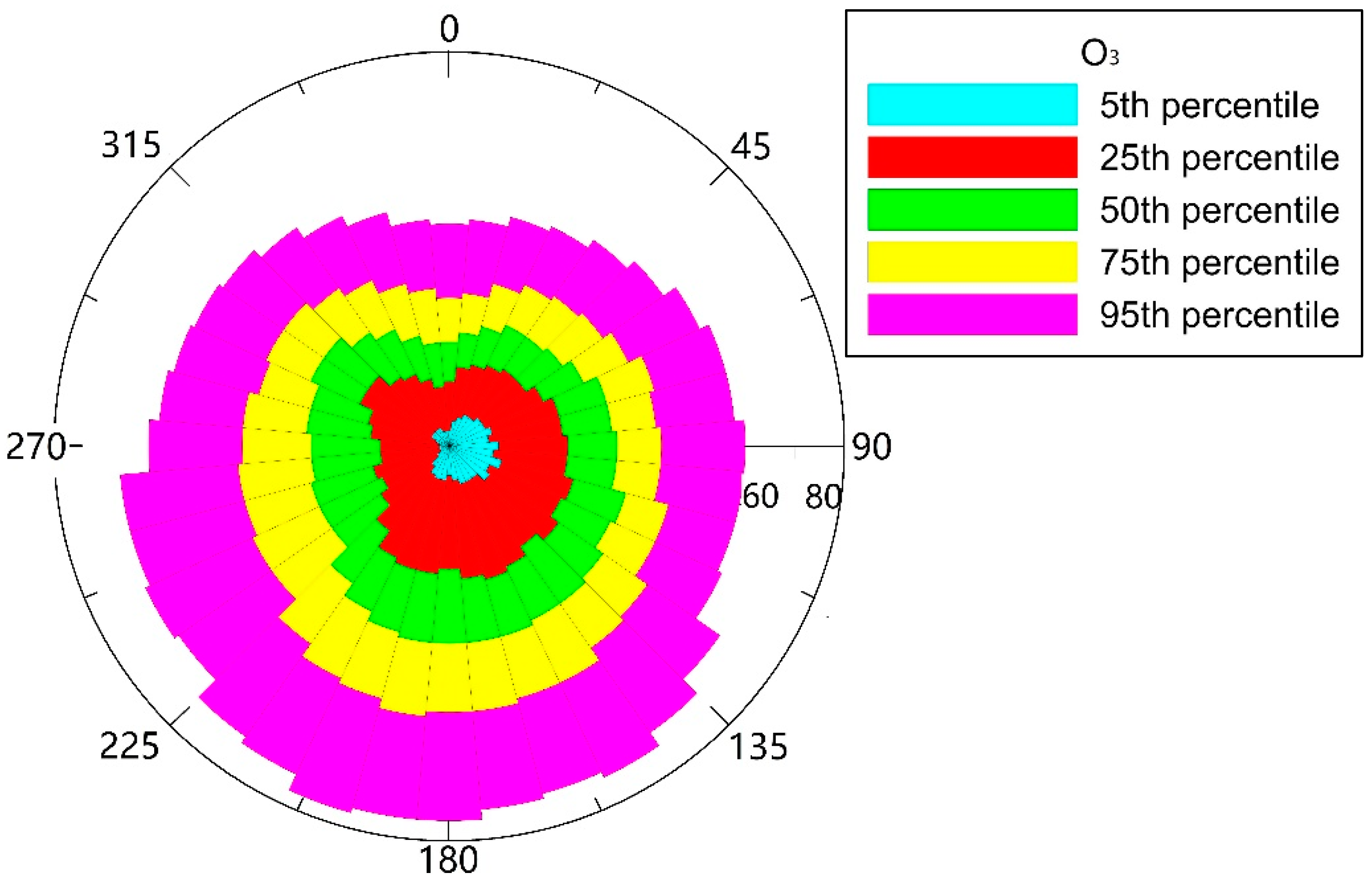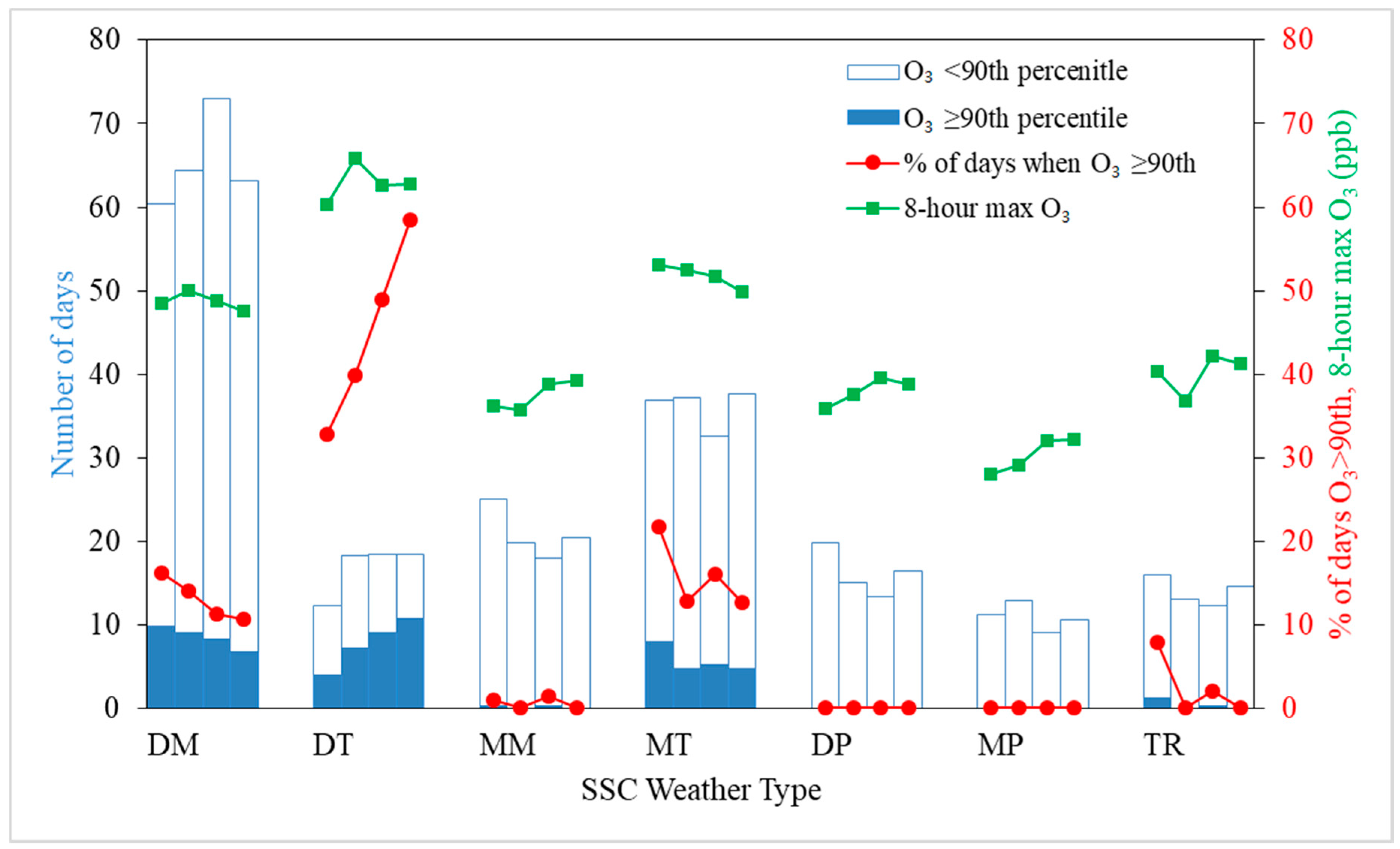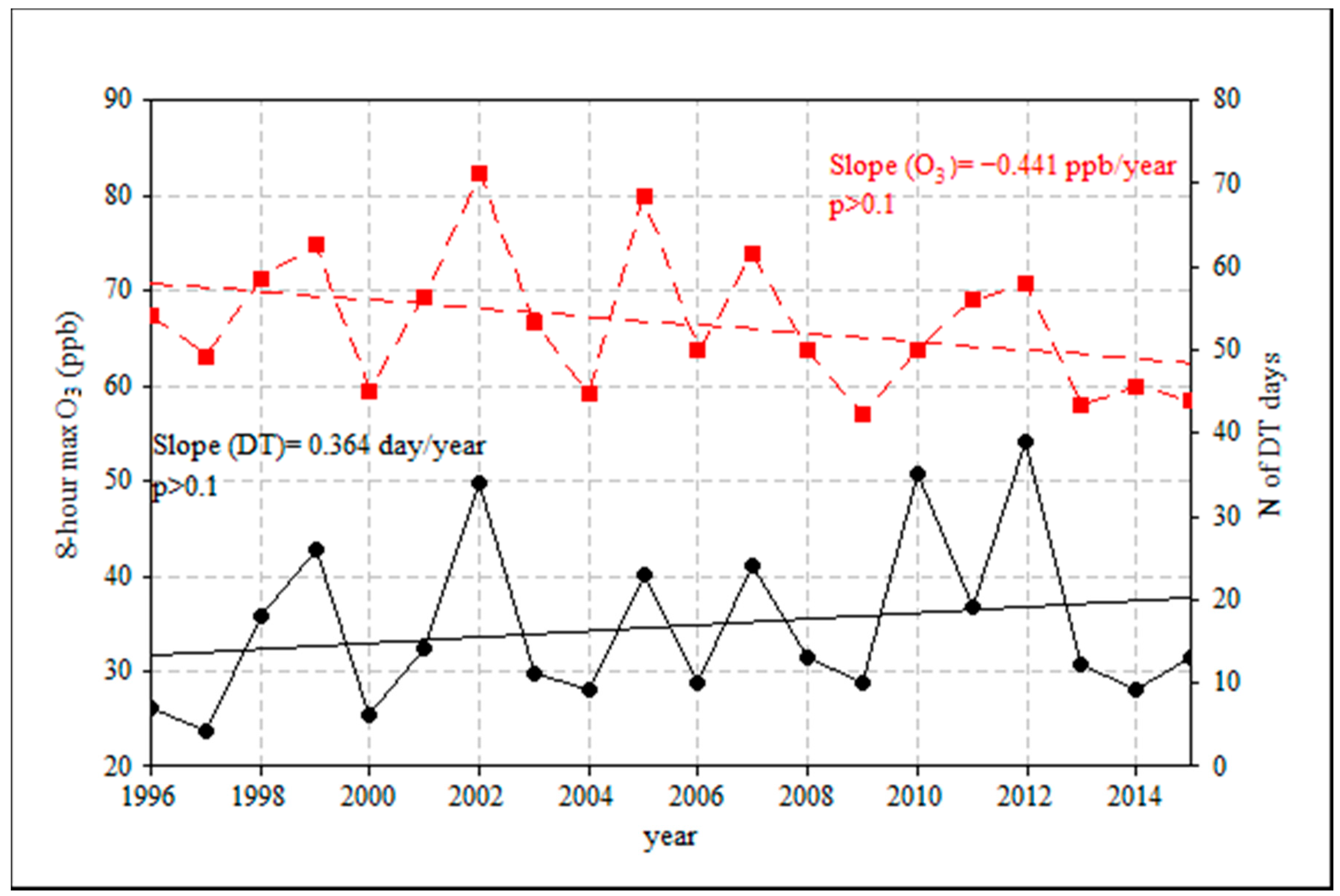Impacts of Regional Transport and Meteorology on Ground-Level Ozone in Windsor, Canada
Abstract
:1. Introduction
2. Methodology
2.1. Data Collection
2.2. Impact of Airmass Movement on O3 Levels in Windsor
2.3. Impact of Meteorological Parameters on O3 Levels in Windsor
2.4. Similarity Analysis
- (1)
- Spearman’s rank correlation coefficients of smog season hourly O3 concentrations, and Pearson correlation coefficients of smog season daily and monthly O3 concentrations, 8 h max and monthly mean 8 h max O3 concentrations between Windsor and each of the five US sites were calculated.
- (2)
- Coefficient of divergence (COD, Pinto et al. [36]) of hourly and 8 h max O3 concentrations in the smog season between Windsor and each of the five US sites were calculated as shown in Equation (1):
3. Results and Discussion
3.1. General Statistics
3.2. Impact of Weather Conditions on O3 Levels in Windsor
3.2.1. Directional O3 Concentrations
3.2.2. Air Mass Trajectory
3.2.3. Effects of Meteorological Parameters
3.2.4. Impact of Synoptic Weather Types
3.3. Similarity in O3 Concentrations between Windsor and the Five US Sites
3.3.1. Correlation
3.3.2. Divergence
4. Conclusions
Supplementary Materials
Author Contributions
Funding
Acknowledgments
Conflicts of Interest
References
- Air Quality Expert Group (AQEG). Ozone in the United Kingdom. 2009. Available online: https://uk-air.defra.gov.uk/assets/documents/reports/aqeg/aqeg-ozone-report.pdf (accessed on 6 July 2020).
- Xu, X.; Zhang, T.; Su, Y. Temporal variations and trend of ground-level ozone based on long-term measurements in Windsor, Canada. Atmos. Chem. Phys. 2019, 19, 7335–7345. [Google Scholar] [CrossRef] [Green Version]
- Lu, X.; Zhang, L.; Shen, L. Meteorology and climate influences on tropospheric ozone: A review of natural sources, chemistry, and transport patterns. Curr. Pollut. Rep. 2019, 5, 238–260. [Google Scholar] [CrossRef] [Green Version]
- Akimoto, H.; Mori, Y.; Sasaki, K.; Nakanishi, H.; Ohizumi, T.; Itano, Y. Analysis of monitoring data of ground-level ozone in Japan for long-term trend during 1990–2010: Causes of temporal and spatial variation. Atmos. Environ. 2015, 102, 302–310. [Google Scholar] [CrossRef]
- Commission for Environmental Cooperation (CEC). Long-Range Transport of Ground Level Ozone and Its Precursors: Assessment of Methods to Quantify Transboundary Transport within the Northeastern United States and Eastern Canada. 1997. Available online: http://www3.cec.org/islandora/en/item/2185-long-range-transport-ground-level-ozone-and-its-precursors-en.pdf (accessed on 6 July 2020).
- Stein, A.F.; Draxler, R.R.; Rolph, G.D.; Stunder, B.J.B.; Cohen, M.D.; Ngan, F. NOAA’s HYSPLIT atmospheric transport and dispersion modeling system. Bull. Amer. Meteorol. Soc. 2015, 96, 2059–2077. [Google Scholar] [CrossRef]
- Rolph, G.; Stein, A.; Stunder, B. Real-time environmental applications and display system: READY. Environ. Model. Softw. 2017, 95, 210–228. [Google Scholar] [CrossRef]
- Aleksic, N.; Kent, J.; Walcek, C. On ground truth in cross-border ozone transport. J. Air Waste Manag. Assoc. 2019, 69, 977–987. [Google Scholar] [CrossRef]
- Lei, R.; Talbot, R.; Wang, Y.; Wang, S.; Estes, M. Surface MDA8 ozone variability during cold front events over the contiguous United States during 2003–2017. Atmos. Environ. 2019, 213, 359–366. [Google Scholar] [CrossRef]
- Stroud, C.; Ren, S.; Zhang, J.; Moran, M.; Akingunola, A.; Makar, P.; Munoz-Alpizar, R.; Leroyer, S.; Bélair, S.; Sills, D.; et al. Chemical analysis of surface-level ozone exceedances during the 2015 Pan American Games. Atmosphere 2020, 11, 572. [Google Scholar] [CrossRef]
- Pérez, I.A.; Artuso, F.; Mahmud, M.; Kulshrestha, U.; Sánchez, M.L.; García, M.A. Applications of air mass trajectories. Adv. Meteorol. 2015. [Google Scholar] [CrossRef]
- Davis, R.E.; Normile, C.P.; Sitka, L.; Hondula, D.M.; Knight, D.B.; Gawtry, S.P.; Stenger, P.J. A comparison of trajectory and air mass approaches to examine ozone variability. Atmos. Environ. 2010, 44, 64–74. [Google Scholar] [CrossRef]
- Fu, J.S.; Streets, D.G.; Jang, C.J.; Hao, J.; He, K.; Wang, L.; Zhang, Q. Modeling regional/urban ozone and particulate matter in Beijing, China. J. Air Waste Manag. 2009, 59, 37–44. [Google Scholar] [CrossRef] [PubMed]
- Yu, S.; Mathur, R.; Kang, D.; Schere, K.; Tong, D. A study of the ozone formation by ensemble back trajectory-process analysis using the Eta-CMAQ forecast model over the Northeastern U.S. during the 2004 ICARTT period. Atmos. Environ. 2009, 43, 355–363. [Google Scholar] [CrossRef]
- Kemball-Cook, S.; Parrish, D.; Ryerson, T.; Nopmongcol, U.; Johnson, J.; Tai, E.; Yarwood, G. Contributions of regional transport and local sources to ozone exceedances in Houston and Dallas: Comparison of results from a photochemical grid model to aircraft and surface measurements. J. Geophys. Res. 2009, 114, 1–14. [Google Scholar] [CrossRef] [Green Version]
- Pugliese, S.; Murphy, J.; Geddes, J.; Wang, J. The impacts of precursor reduction and meteorology on ground-level ozone in the Greater Toronto Area. Atmos. Chem. Phys. 2014, 14, 8197–8207. [Google Scholar]
- Geddes, J.A.; Murphy, J.G.; Wang, D.K. Long term changes in nitrogen oxides and volatile organic compounds in Toronto and the challenges facing local ozone control. Atmos. Environ. 2009, 43, 3407–3415. [Google Scholar] [CrossRef]
- Liu, L.; Talbot, R.; Lan, X. Influence of climate change and meteorological factors on Houston’s air pollution: Ozone a case study. Atmosphere 2015, 6, 623–640. [Google Scholar] [CrossRef] [Green Version]
- Reynolds, R. Synoptic meteorology—Weather maps. In Encyclopedia of Atmospheric Sciences, 2nd ed.; North, G.R., Pyle, J., Zhang, F., Eds.; Academic Press: Cambridge, MA, USA, 2015; pp. 289–298. [Google Scholar]
- Moghani, M.; Archer, C.; Mirzakhalili, A. The importance of transport to ozone pollution in the U.S. Mid-Atlantic. Atmos. Environ. 2018, 191, 420–431. [Google Scholar] [CrossRef]
- Jing, P.; O’Brien, T.; Streets, D.G.; Patel, M. Relationship of ground-level ozone with synoptic weather conditions in Chicago. Urban Clim. 2016, 17, 161–175. [Google Scholar] [CrossRef]
- Oyola, M.; Schneider, A.; Campbell, J.; Joseph, E. Meteorological influences on tropospheric ozone over suburban Washington, DC. Aerosol Air Qual. Res. 2018, 18, 1168–1182. [Google Scholar] [CrossRef] [Green Version]
- Archer, C.; Brodie, J.; Rauscher, S. Global warming will aggravate ozone pollution in the U.S. mid-Atlantic. J. Appl. Meteor. Climatol. 2019, 58, 1267–1278. [Google Scholar] [CrossRef]
- Han, H.; Liu, J.; Shu, L.; Wang, T.; Yuan, H. Local and synoptic meteorological influences on daily variability in summertime surface ozone in eastern China. Atmos. Chem. Phys. 2020, 20, 203–222. [Google Scholar] [CrossRef] [Green Version]
- Ministry of the Environment (MOE). Transboundary Air Pollution in Ontario; PIBS 5158e: Toronto, ON, Canada, 2005. Available online: http://www.airqualityontario.com/downloads/TransboundaryAirPollutionInOntario2005.pdf (accessed on 27 July 2020).
- Ministry of the Environment and Climate Change (MOECC). Air Quality in Ontario 2015 Report; Queen’s Printer for Ontario: Toronto, ON, Canada, 2017; ISSN 1710-8136. Available online: http://www.airqualityontario.com/downloads/AirQualityInOntarioReportAndAppendix2015.pdf (accessed on 27 July 2020).
- Ministry of the Environment, Conservation and Parks (MECP). Windsor Downtown: Station Information. 2020. Available online: http://www.airqualityontario.com/history/station.php?stationid=12008 (accessed on 6 July 2020).
- United States Environmental Protection Agency (USEPA). Pre-Generated Data Files. 2020. Available online: https://aqs.epa.gov/aqsweb/airdata/download_files.html (accessed on 6 July 2020).
- Ministry of the Environment (MOE). Air Quality in Ontario Report for 2011; Queen’s Printer for Ontario, PIBS 9196e: Toronto, ON, Canada, 2013. Available online: http://www.airqualityontario.com/downloads/AirQualityInOntarioReportAndAppendix2011.pdf (accessed on 27 July 2020).
- Zhang, T. Long-Term Trend of Ground-Level Ozone through Statistical and Regional Transport Analysis. Master’s Thesis, University of Windsor, Windsor, ON, Canada, 2016. Available online: http://scholar.uwindsor.ca/etd/5880/ (accessed on 15 October 2020).
- United States Environmental Protection Agency (USEPA). Guideline on Data Handling Conventions for the 8-h Ozone NAAQS, Research Triangle Park, NC. 1998. Available online: https://www3.epa.gov/ttn/naaqs/aqmguide/collection/cp2_old/19981201_oaqps_epa-454_r-99-017.pdf (accessed on 6 July 2020).
- Environment and Climate Change Canada (ECCC). Historical Climate Data. 2020. Available online: http://climate.weather.gc.ca/index_e.html (accessed on 6 July 2020).
- Kent State University (KSU). Spatial Synoptic Classification. 2020. Available online: http://sheridan.geog.kent.edu/ssc.html (accessed on 6 July 2020).
- National Oceanic and Atmospheric Administration (NOAA). What Are the Differences between EDAS, GDAS, FNL, REANALYSIS, and NGM Meteorological Datasets? 2020. Available online: https://www.ready.noaa.gov/faq_md3.php (accessed on 15 May 2020).
- Barrado, A.L.; García, S.; Barrado, E.; Pérez, R.M. PM2.5-bound PAHs and hydroxy-PAHs in atmospheric aerosol samples: Correlations with season and with physical and chemical factors. Atmos. Environ. 2012, 49, 224–232. [Google Scholar] [CrossRef]
- Pinto, J.P.; Lefohn, A.S.; Shadwick, D.S. Spatial variability of PM2.5 in urban areas in the United States. J. Air Waste Manag. Assoc. 2004, 54, 440–449. [Google Scholar] [CrossRef] [PubMed] [Green Version]
- Kavouras, I.G.; DuBois, D.W.; Etyemezian, V.; Nikolich, G. Spatiotemporal variability of ground level ozone and influence of smoke in Treasure Valley, Idaho. Atmos. Res. 2013, 124, 44–52. [Google Scholar] [CrossRef]
- Jing, P.; Lu, Z.; Xing, J.; Streets, D.G.; Tan, Q.; O’Brien, T. Response of the summertime ground level ozone trend in the Chicago area to emission controls and temperature changes, 2005–2013. Atmos. Environ. 2014, 99, 630–640. [Google Scholar] [CrossRef]
- Lei, R.; Talbot, R.; Wang, Y.; Wang, S.C.; Estes, M. Influence of cold fronts on variability of daily surface O3 over the Houston-Galveston-Brazoria area in Texas USA during 2003–2016. Atmosphere 2018, 9, 159. [Google Scholar] [CrossRef] [Green Version]
- Plocoste, T.; Dorville, J.-F.; Monjoly, S.; Jacoby-Koaly, S.; André, M. Assessment of nitrogen oxides and ground-level ozone behavior in a dense air quality station network: Case study in the Lesser Antilles Arc. J. Air Waste Manag. Assoc. 2018, 68, 1278–1300. [Google Scholar] [CrossRef] [Green Version]
- United States Environmental Protection Agency (USEPA). Ground Level Ozone: Occurrence and Transport in Eastern North America. 1999. Available online: https://www.epa.gov/sites/production/files/2015-07/documents/ground-level_ozone_occurrence_and_transport_in_eastern_north_america.pdf (accessed on 18 May 2020).
- Johnson, D.; Mignacca, D.; Herod, D.; Jutzi, D.; Miller, H. Characterization and identification of trends in average ambient ozone and particulate matter levels through trajectory cluster analysis in Eastern Canada. J. Air Waste Manag. Assoc. 2007, 57, 907–918. [Google Scholar] [CrossRef]
- Gálvez, O. Synoptic-scale transport of ozone into Southern Ontario. Atmos. Environ. 2007, 41, 8579–8595. [Google Scholar] [CrossRef]
- Susaya, J.; Kim, K.H.; Shon, Z.H.; Brown, R.J. Demonstration of long-term increases in tropospheric O3 levels: Causes and potential impacts. Chemosphere 2013, 92, 1520–1528. [Google Scholar] [CrossRef]
- Shan, W.; Yin, Y.; Lu, H.; Liang, S. A meteorological analysis of ozone episodes using HYSPLIT model and surface data. Atmos. Res. 2009, 93, 767–776. [Google Scholar] [CrossRef]






| Site Name | Province/States | Latitude (Degree) | Longitude (Degree) | Elevation above Sea Level (m) | Site Type | Distance to Windsor (km) | Data Availability |
|---|---|---|---|---|---|---|---|
| Windsor Downtown | Ontario | 42.31 | −83.04 | 176 | Urban | - | 1996–2015 |
| Allen Park | Michigan | 42.22 | −83.20 | 181 | Suburban | 17 | 1996–2015 |
| Lansing | Michigan | 42.73 | −84.53 | 268 | Urban | 130 | 1996–2015 |
| Erie | Ohio | 41.64 | −83.54 | 176 | Urban | 85 | 1998–2015 |
| Delaware | Ohio | 40.35 | −83.06 | 275 | Rural | 218 | 1996–2015 |
| National Trail School | Ohio | 39.83 | −84.72 | 357 | Rural | 310 | 1997–2015 |
| Sites | Mean | SD | CV (%) | 5th Percentile | 25th Percentile | Median | 75th Percentile | 95th Percentile | Max | Sample Size |
|---|---|---|---|---|---|---|---|---|---|---|
| Windsor | 31.7 | 18.2 | 57.5 | 4 | 19 | 30 | 43 | 64 | 128 | 85,259 |
| Allen Park | 26.7 | 18.4 | 68.6 | 1 | 12 | 26 | 39 | 59 | 123 | 83,998 |
| Erie | 28.0 | 17.9 | 63.8 | 2 | 14 | 27 | 40 | 59 | 121 | 75,998 |
| Lansing | 33.9 | 16.9 | 49.9 | 6 | 22 | 33 | 45 | 63 | 110 | 85,693 |
| Delaware | 34.6 | 19.3 | 55.8 | 4 | 20 | 34 | 48 | 68 | 161 | 79,203 |
| NTS | 33.1 | 18.4 | 55.5 | 2 | 20 | 33 | 46 | 64 | 121 | 86,811 |
| Cluster (Air Mass Direction) | 8 h Max O3 (ppb) | Number of Days | Daily Mean Temp (°C) | Daily Mean Relative Humidity (%) | Daily Mean Wind Speed (km/h) | Daily Mean Atmospheric Pressure (kPa) | Percentage of Rainy Days (%) |
|---|---|---|---|---|---|---|---|
| 1 (300°–50°) | 40.2 | 1134 | 16.5 | 66.3 | 14.1 | 99.3 | 4.3 |
| 2 (60°–150°) | 45.9 | 614 | 16.4 | 68.2 | 12.4 | 99.6 | 9.3 |
| 3 (160°–290°) | 51.0 | 1752 | 19.8 | 68.0 | 14.6 | 99.2 | 4.7 |
| Day | Sample Size | 8 h Max O3 (ppb) | Daily Max Temp (°C) | Daily Mean Temp (°C) | Daily Mean Relative Humidity (%) | Daily Mean Wind Speed (km/h) | Daily Mean Atmospheric Pressure (kPa) |
|---|---|---|---|---|---|---|---|
| High O3 | 366 | 74.6 | 29.4 | 23.7 | 63.5 | 11.5 | 99.4 |
| Low O3 | 366 | 24.1 | 17.8 | 14.4 | 74.8 | 15 | 99.2 |
| All | 3660 | 46.6 | 22.9 | 18.1 | 67.5 | 14.1 | 99.3 |
| Sites | Hourly O3 | 8 h Max O3 | Rank | |||
|---|---|---|---|---|---|---|
| Hourly a | Daily Mean b | Monthly Mean b | Daily b | Monthly Mean b | ||
| Allen Park | 0.876 | 0.894 | 0.890 | 0.920 | 0.911 | 1 |
| Erie | 0.766 | 0.749 | 0.756 | 0.824 | 0.823 | 3 |
| Lansing | 0.778 | 0.817 | 0.836 | 0.827 | 0.847 | 2 |
| Delaware | 0.689 | 0.588 | 0.554 | 0.694 | 0.715 | 4 |
| NTS | 0.567 | 0.408 | 0.653 | 0.587 | 0.676 | 5 |
| Site | Cluster 3 (160°–290°, N = 1752) | Clusters 1 and 2 (300°–150°, N = 1748) | Rank |
|---|---|---|---|
| Allen Park | 0.936 | 0.897 | 1 |
| Eire | 0.849 | 0.806 | 2 |
| Lansing | 0.834 | 0.801 | 3 |
| Delaware | 0.707 | 0.606 | 4 |
| NTS | 0.635 | 0.528 | 5 |
| Sites | Hourly O3 | 8 h Max O3 | Rank |
|---|---|---|---|
| Allen Park | 0.273 | 0.106 | 2 |
| Erie | 0.291 | 0.118 | 3 |
| Lansing | 0.260 | 0.099 | 1 |
| Delaware | 0.302 | 0.136 | 4 |
| NTS | 0.338 | 0.148 | 5 |
Publisher’s Note: MDPI stays neutral with regard to jurisdictional claims in published maps and institutional affiliations. |
© 2020 by the authors. Licensee MDPI, Basel, Switzerland. This article is an open access article distributed under the terms and conditions of the Creative Commons Attribution (CC BY) license (http://creativecommons.org/licenses/by/4.0/).
Share and Cite
Zhang, T.; Xu, X.; Su, Y. Impacts of Regional Transport and Meteorology on Ground-Level Ozone in Windsor, Canada. Atmosphere 2020, 11, 1111. https://doi.org/10.3390/atmos11101111
Zhang T, Xu X, Su Y. Impacts of Regional Transport and Meteorology on Ground-Level Ozone in Windsor, Canada. Atmosphere. 2020; 11(10):1111. https://doi.org/10.3390/atmos11101111
Chicago/Turabian StyleZhang, Tianchu, Xiaohong Xu, and Yushan Su. 2020. "Impacts of Regional Transport and Meteorology on Ground-Level Ozone in Windsor, Canada" Atmosphere 11, no. 10: 1111. https://doi.org/10.3390/atmos11101111
APA StyleZhang, T., Xu, X., & Su, Y. (2020). Impacts of Regional Transport and Meteorology on Ground-Level Ozone in Windsor, Canada. Atmosphere, 11(10), 1111. https://doi.org/10.3390/atmos11101111





